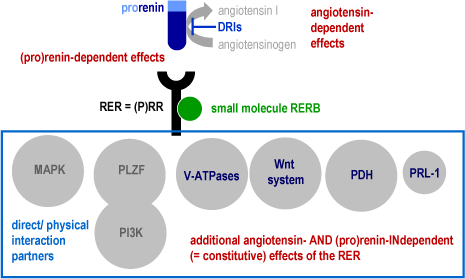RERBs - mechanism of action

The RER mediates angiotensin II-dependent, (pro)renin-dependent as well as constitutive (e.g. via PDH and Wnt signalling) effects.
From a network perspective, the RER represents an upstream nodal point due to its plethora of adapter proteins.
RERBs act at the (pro)renin receptor and its downstream adapters, some of which mediate constitutive (i.e., ligand-independet) effects, i.e., RERBs affect the intrinsic receptor activity/ RER signalling.
In contrast, DRIs such as aliskiren inhibit the enzymatic activity of (pro)renin (i.e., the generation of angiotensin I). In this context, it is of importance to note that aliskiren does not inhibit the intrinsic activity of prorenin and renin as ligands at the RER, i.e., the aliskiren-(pro)renin complex is still able to activate the RER.
Therefore, RERBs and aliskiren are mechanistically distinct.
abbreviations
- RER = (P)RR = renin/ prorenin receptor = (pro)renin receptor
- RERBs = renin/ prorenin receptor blockers
- DRIs = direct renin inhibitors, e.g. aliskiren
- MAPK = MAP (mitogen-activated protein) kinases
- PDH = pyruvate dehydrogenase
- PI3K = phosphatidylinositol-3 kinase
- PLZF = promyelocytic leukemia zinc finger protein, a transcription factor
- PRL-1 = phosphatase of regenerating liver-1
references
- Nguyen, JCI 2002
- Ichihara, JCI 2004
- Schefe, Circ. Res. 2006
- Schefe, J. Hypertens. 2008
- Cruciat, Science 2010
- Funke-Kaiser, Hypert. Res. 2010
- Bernhard, Biochem. Pharm. 2012
- Kirsch, Int. J. Mol. Med. 2014
- Kanda, JBC 2015
